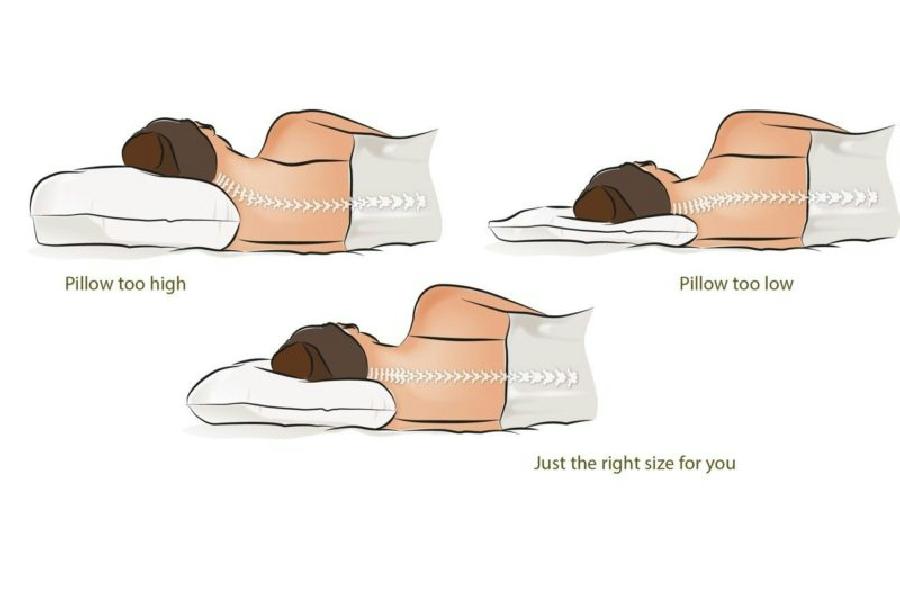Suffering from neck pain: What pillows should I use?
24 March 2023

Neck pain is common in people of all ages. There can be a variety of reasons for this discomfort. Working all day bent over a smartphone or computer, driving long distances, poor posture while standing or sitting, stress and tiredness are all factors that can cause the muscles in the neck and upper back to become tight and the joints to become stiff, which can contribute to ongoing neck pain.
Here at Brixworth Osteopathic Clinic patients with low back pain used to be the majority of patients we saw - however, times are changing and over the last couple of years, we see at least as many patients presenting with neck or head pain.
Neck pain can be one of the most common issues that sufferers of poor sleep cite as a key reason for their inability to get to sleep, continual waking in the middle of the night or having regular night of poor quality sleep. As its National Bed Month and recently Sleep Awareness Week, we thought we would try to provide advice for some of the most common questions we get asked:
“what pillow should I use”?, “how many should I use?” and “what’s the best sleeping position in bed?”
Below are a few tips for keeping on top of your neck pain through the appropriate use of pillows:
Number of pillows:
We all have different postures, size of frame (e.g shoulder width) and curvatures in our spine so some people may need more pillows than others. The most important thing to make sure is that your spine is in a neutral position when you’re sleeping and that you are comfortable.
Type of pillow:
There are many opinions regarding the type of pillow to use but our advice is to stick to your own preference and comfort, and don’t break the bank balance whilst doing so. Providing that your spine isn’t sinking into your lovely new thick duck feathered pillow and causing an unnatural curvature in your spine, or that firm orthopaedic cervical pillow isn’t propping your head up too much, then the type of pillow that you use shouldn’t make all that much of a difference. Most people now have access to a reasonable quality mattress so much of the problems can come from the pillows. The following picture picture gives a good indication.

Sleeping Position:
Generally speaking sleeping on your side, particularly if suffering with neck pain, is usually the most comfortable position. Ask you partner, family member or friend to take a look at your overall alignment whilst on your bed and see if it fits with the positions below. Of course sleep positions are typically habits formed over many years so we will break this down,
- Side-sleepers: Try a softer pillow on top of a firm pillow so you can mould the top pillow to support and fill the gap between your head and shoulder. Having a pillow between your legs or to rest your arm on is a good idea to to support your lower back/pelvis and shoulder.
- Back-sleepers: Ensure your pillow(s) enable your head and neck to be aligned with the rest of your spine, not flexed forwards. Sometime a pillow under your knees can be very comfortable in this position, and it can also protect you lower back!
- Front-sleepers: Simply……try not to lie on your front as this will put strain through your neck and upper back. Imagine standing up look at the ceiling for 8 hours? This is essentially what you are asking your body to do when you sleep on your front, and I'm sure you agree its not very comfortable.
If this position is really the only way you can sleep, try sleeping with one knee bent up and use just a small flat pillow under your head and neck. A pillow under your stomach is likely to help as well.
Other Top Tips:
Moving away slightly from pillows- when you do go to bed; make sure not to be stimulated by being on a computer or on your phone before trying to get to sleep. Not only can using your phone before bed have a negative on your sleep, it can also aggravate neck pain. The muscles in your neck can become fatigued from having to hold your head up whilst on your phone all night. This in turn could lead to muscle and joint pains in the upper back and neck.
Of course if you feel you want to bring your pillows along with you when having a consultation then - our osteopaths will be more than happy to help!
Do we recommend specific pillows?
Yes we do but only as an option to consider. Our new pillow partner is quite aptly named, The Original Groove® Pillow, formerly EasySleeper, it has been designed by those with neck pain to combat one or two of the most common predispositions to neck pain and back pain in the UK, if not the world….Posture and Sleep.
The Original Groove® Pillow is brilliant at absorbing the weight of the head and supporting the neck and shoulders. It achieves this by keeping its shape, especially during longer hours, unlike conventional pillows, reducing deformation.
This results in a good nights sleep that is not only less arduous on the mechanics of the spine as it maintains your body’s ideal alignment, it is less likely to result in neck or back pain. Check them out - our patients can receive a discount code that make the pillow even more affordable.
Osteopaths can help you
Please note, these tips constitute general advice. If your neck or joint pain persists, make sure you see a qualified therapist such as osteopath to work out the cause of your pain and how best to treat it. As we mentioned above neck pain that relates to headaches or shoulder pain are the most common things we see, and our primary practitioner training allows us to thoroughly assess you to safely find the cause and in the vast majority of cases help relieve the symptoms.
